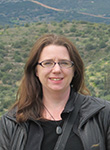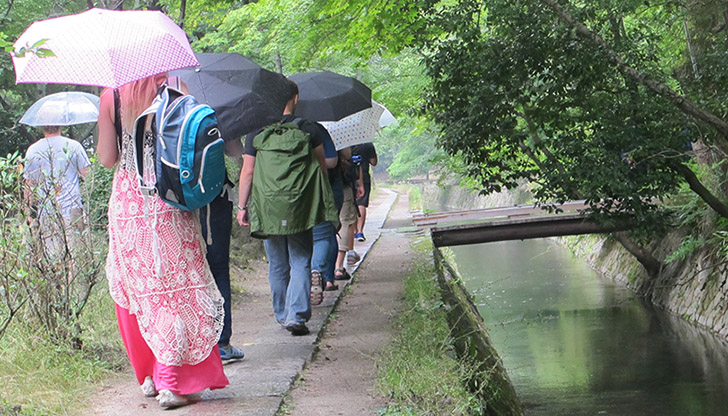There and Back Again: Study Abroad and the Traditional Classroom
Teaching Strategy
In July of 2013, I found myself on a plane to Japan with nine very excited students. I say “found myself” because I remember very little of getting to the airport. I had flown in from Rome the night before, after stepping in as a last-minute chaperone for a study abroad to Italy. After four hours of sleep I was back on a plane. The preparation time I had scheduled immediately before the trip hadn’t happened, and any last-minute planning with my colleague (who is also my husband) was promptly undermined by my falling into a very deep sleep.
After a long plane ride, an unfortunately planned but successful train trip, and a few taxis, we were in the heart of Nagoya around 6 pm. Our small neighborhood had everything I had hoped for: the “western-style” hotel to help ease any possible culture shock, a variety of different restaurants for the students to explore, and the typical tiny Shinto shrines that are found in each block of the city. The majority of our students had not been outside of the United States; in fact, three of them had never been on a plane. Though I knew we needed to help the students adjust, I would be lying if I said that I didn’t need to adjust as well. This was my first trip to Asia, and while my experience with traveling in other areas served for basics like metro systems and currency exchange, I quickly realized that Rome and Nagoya are drastically different!
The first thing I noticed the next morning was the reaction of the students to the range of religious practices they observed. They were not accustomed to people engaging in multiple religions at the same time and in the same place. Simply wandering around the grounds of Atsuta Shrine and Osu Kannon in Nagoya, for example, demonstrated the combinations of Shinto, Buddhist, and folk and indigenous religious iconography and practices. While I do typically start my semester-long world religions courses by discussing issues of syncretism and combinations of practice, and many of our study abroad students had heard similar lectures before, the experience was quite different for them. This overlapping of traditions became a very interesting entry point into discussion both on the trip and later in my home classroom.
Our goals for this trip, and the assignments required, were relatively straightforward: a short paper before the trip addressing a major site, a daily journal kept during the trip, and a longer theoretical/reflective paper after the conclusion of the trip. Part of the first assignment was also to take place each day. Students were expected to contribute to the on-site teaching for their particular place. It was this assignment that proved to be the most effective for learning, as well as being the assignment that started my thinking about how to best incorporate “the classroom” into study abroad, and how to bring those ideas back into the traditional classroom at WVU.
Background and Theory
Short-term study abroad trips appear to incorporate “active learning” by their very nature, yet the broad scope of the programs can be overwhelming, especially when combined with first-time travel. Since we do not usually hire guides for large portions of the trip, it is part of our faculty responsibilities to cover historical background, religious significance of sites, and other main points along the way.
Obviously there are a variety of ways to incorporate lecture into any study abroad program. On previous trips, I had observed or participated in several different setups: nightly one-hour lectures; on-site, hands-on instruction (in the case of an archaeology-based trip); planned and/or off-the-cuff lectures at stops during the day. As someone who likes to incorporate visual aids into any class, I prefer on-site lecture and discussions while traveling. Lecturing on medieval women mystics immediately before taking students to view the head-relic of Catherine of Siena is difficult to top!
As we hoped, allowing the students to take over part of the responsibility for on-site “lecture” accomplished several key things. First, even limited to a specific city or site focus, the students gained a good knowledge of the larger context we were exploring. For example, though they had (hopefully) looked at a map before leaving the United States, few of the students had any idea of the relative size of cities and their suburbs. Researching a particular site and its historical context seemed to bring the country as a whole into clearer focus for each of the students.
Second, the idea of serving as the class’s designated expert on a particular site or city, and sharing that information with their peers, did seem to encourage in-depth learning for students. This is not surprising if one accepts the idea that teaching others is an effective learning tool. As an added bonus, I found that the students were more likely to stop and pay close attention to the information from their peers, knowing that all the students were equally “on the spot” for the information at their chosen site.
Finally, the students also learned a great deal from the very real interaction between theory and practice. In other words, we can talk all we want about purification rituals in Shinto, but the students gained far more from observing how people followed (or didn’t follow) the correct rules. Many of their final papers ended up reflecting on how “real life” varied from our textbook explanations. This is, for me, the real benefit of study abroad.
Conclusions and Extensions
Obviously, the city/site presentation is a version of a teaching and learning technique that many of us already use in the classroom. In my other courses, I have been experimenting with extremely short on-the-spot group presentations. In my humanities course, for example, I assign a piece of art for a group to examine and discuss in the context of the period we are covering. After five or ten minutes, they deliver a brief summary of their findings to the rest of the class.
Study abroad experiences don’t end when the trip does. Over the last three years I’ve stayed in contact with the majority of students and have seen repeated instances where a three-week trip has changed the direction or focus of a student’s studies. Two of our students from the 2013 Japan trip applied to teach English in Japan after graduation and a student from the 2014 Japan trip is enrolling in an intensive Japanese language internship in summer 2015.
As a teacher, I have found myself blending many of the images and lessons learned by our overseas students into my traditional classroom, and this is the area where I believe our study abroad experiences can continue to be developed. My goal after our programs this summer is to incorporate even more of the students’ own experiences into my classrooms, in part by having a short presentation at WVU as an option for the study abroad assignments. Many of our students already help us staff our Study Abroad Fair table and speak at informational sessions; the incoming students take previous stories very seriously. In a state where international travel is not terribly common, I am excited to develop new ways of incorporating the “student-as-instructor” role into my classroom at home.
Resources
Gonsalvez, J. 2013. “The Pedagogy of Short-Term Study-Abroad Programs.” Journal of Arts and Humanities 2 (8): 1–5.
Morgan, Robert L., James E. Whorton, and Cynthia Gunsalus. 2000. "A Comparison of Short Term and Long Term Retention: Lecture Combined with Discussion versus Cooperative Learning." Journal of Instructional Psychology 27 (1): 53.
Paulson, D. R., & Jennifer L.F. 2002. Active Learning for The College Classroom. Los Angeles. http://web.calstatela.edu/dept/chem/chem2/Active/
Perry L, Stoner L, Tarrant M. 2012. “More than a Vacation: Short-term Study Abroad as a Critically Reflective, Transformative Learning Experience.” Creative Education 3 (5): 679–683.
 Alyssa J. Beall completed her PhD at Syracuse University and is a lecturer at West Virginia University in Morgantown. Over the last three years she has co-coordinated and taught study abroad programs in Vietnam, Cambodia, Japan, and Spain. Although she teaches classroom-based courses during the semester, she is also interested in continuing improvements to "nontraditional" teaching, both in travel courses and online. Her primary research focuses on gender studies and popular culture in religions.
Alyssa J. Beall completed her PhD at Syracuse University and is a lecturer at West Virginia University in Morgantown. Over the last three years she has co-coordinated and taught study abroad programs in Vietnam, Cambodia, Japan, and Spain. Although she teaches classroom-based courses during the semester, she is also interested in continuing improvements to "nontraditional" teaching, both in travel courses and online. Her primary research focuses on gender studies and popular culture in religions.
Image: West Virginia University 2014 Study Abroad Students. Tetsugaku-no-Michi, Kyoto, Japan, 2014. Photo Credit: Alex Snow

